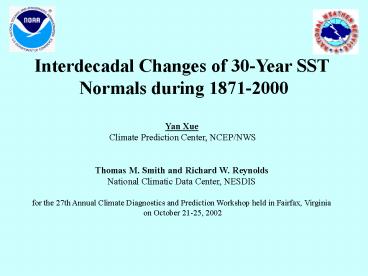Interdecadal Changes of 30-Year SST - PowerPoint PPT Presentation
Title:
Interdecadal Changes of 30-Year SST
Description:
for the 27th Annual Climate Diagnostics and Prediction Workshop held in Fairfax, Virginia ... Standard Deviation of the eleven 30-year seasonal CMs in 1871-2000. ... – PowerPoint PPT presentation
Number of Views:28
Avg rating:3.0/5.0
Title: Interdecadal Changes of 30-Year SST
1
Interdecadal Changes of 30-Year SST Normals
during 1871-2000 Yan Xue Climate Prediction
Center, NCEP/NWS Thomas M. Smith and Richard W.
Reynolds National Climatic Data Center,
NESDIS for the 27th Annual Climate Diagnostics
and Prediction Workshop held in Fairfax,
Virginia on October 21-25, 2002
2
Motivation
- A 30-year SST normal includes climatological mean
and standard deviation, and is defined in a
30-year base period. - 30-year SST normals used at CPC
- 1951-1979 normal
- 1961-1990 normal
- 1971-2000 normal
- 30-year normals recommended by WMO
- 1951-1980, 1961-1990 and 1971-2000,
- Interdecadal changes of the 30-year normals in
the past 130 years (1871-2000).
3
Review
- Interannual variability associated with ENSO is
high during 1880-1920 and 1960-1990 and low
during 1920-1960 (Kestin et al. 1998
Mestat-Nunez and Enfield 2001). - Pacific Decadal Oscillation (PDO) in the North
Pacific (Mantua et al. 1997). - Decadal and interdecadal variability related to
the North Atlantic Oscillation in the North
Atlantic (Kushnir 1994). - Decadal and interdecadal variability in the
tropical Atlantic. - Decadal and interdecadal variability in the
Indian Ocean.
4
Approach
- Calculate climatological mean (CM) and standard
deviation (SD) in sliding 30-year windows in the
past 130 years. - (1871-1900, 1881-1910, 1891-1920, )
- Use two independent SST analyses.
- Make conclusions based on the consistent results
from the two SST analyses.
5
Goals
- Primary goals
- Estimate interdecadal variability in the global
ocean. - Estimate interdecadal changes of interannual
variability in the global ocean. - Estimate interdecadal changes of seasonal
persistence. - Secondary goals
- Provide justification on why the 30-year SST
normal needs to be updated every 10 years. - Estimate the uncertainties in the two SST
analyses.
6
Data
- Extended Reconstructed Sea Surface Temperature
(ERSST) by Smith and Reynolds (2002). - Period 1854-2000 Resolution 2O x 2O
- Fitting COADS in situ observations to a set of
EOFs - Analyzing low- and high-frequency variations
separately. - Hadley Centres Sea Ice and Sea Surface
Temperature (HadISST) by Rayner et al. (2002). - Period 1871-1999 Resolution 1O x 1O
- Combination of global SST and sea ice
concentration. - Using reduced-space optimal interpolation.
7
Methodology
- Seasonal Climatological Mean (CM)
- Calculating monthly CM by averaging monthly SST
over appropriate 30-year base periods. - Averaging monthly CM over appropriate seasons.
- Seasonal Standard Deviation (SD)
- Deriving monthly anomalies by subtracting monthly
CM from monthly data. - Deriving seasonal anomalies by averaging monthly
anomalies over appropriate seasons. - Deriving seasonal SD from seasonal anomalies.
- Seasonal Persistence (P)
- Auto-correlation of seasonal anomalies at a
two-season lag over appropriate 30-year base
periods.
8
Standard Deviation of Seasonal CM
Standard Deviation of the eleven 30-year seasonal
CMs in 1871-2000.
9
Standard Deviation of CM in SON
PDO
NAO
INDIAN
SATL
NINO3
10
INDIAN Index (45O-100OE, 10OS-25ON)
Departures from the seasonal CM averaged over all
the 30-year base periods during 1871-2000.
Years
Differences between HadISST and ERSST
Years
Seasons
11
PDO Index (160OE-160OW, 35ON-45ON)
Departures from the seasonal CM averaged over all
the 30-year base periods during 1871-2000.
Years
Differences between HadISST and ERSST
Years
Seasons
12
NAO Index (60OW-20OW, 40ON-60ON)
Departures from the seasonal CM averaged over all
the 30-year base periods during 1871-2000.
Years
Differences between HadISST and ERSST
Years
Seasons
13
SATL Index (35OW-10OE, 22OS-2ON)
Departures from the seasonal CM averaged over all
the 30-year base periods during 1871-2000.
Years
Differences between HadISST and ERSST
Years
Seasons
14
NINO3 Index (150OW-90OW, 5OS-5ON)
Departures from the seasonal CM averaged over all
the 30-year base periods during 1871-2000.
Years
Differences between HadISST and ERSST
Years
Seasons
15
Average season SD
HadISST-ERSST
16
Seasonal SD of NINO3
- Variance is largest in NDJ and smallest in MAM.
- Variance is intermediate in 1871-1920, small in
1930-1950 and large in 1960-2000. - Seasonality of variance is moderate in
1871-1920, weak in 1930-1950 and strong in
1960-2000.
1971-2000
1961-1990
1951-1980
Average in 1871-2000
Average in MAM
Years
Average in NDJ
Seasons
17
Seasonal SD of Darwin SLP
1971-2000
1961-1990
1951-1980
Average in 1871-2000
Average in MAM
Years
Average in NDJ
Seasons
18
Seasonal Persistence
19
Seasonal Persistence of NINO3
- Persistence is largest in JJA and smallest in
DJF. - Seasonality of persistence is weak in 1871-1910,
moderate in 1920-1950, strong in 1955-1975, and
moderate in 1975-2000. - Predictability is high in 1871-1920, low in
1920-1940, and high in 1950-2000.
1951-1980
P0.4
Average in DJF
Years
Average in JJA
Seasons
20
Summary
- The interdecadal changes of seasonal CM are
prominent (0.3-0.6OC) in the tropical Indian
Ocean, the middle latitude North Pacific and
North Atlantic, most of the South Atlantic and
the Sub-Antarctic Front. - The tropical Indian and Atlantic show a warming
trend, and the middle latitude North Pacific and
North Atlantic show multidecadal oscillations. - The seasonal SD is prominent (0.5-1.3OC) in the
eastern equatorial Pacific, the middle latitude
North Pacific and North Atlantic. - The seasonal SD of NINO3 varies interdecadally,
intermediate during 1885-1915, small during
1910-1965 and large during 1965-2000. - The seasonal P is largest in the eastern
equatorial Pacific, the tropical Indian and
Atlantic. - The seasonal P of NINO3 varies interdecadally,
high during 1885-1920, low during 1920-1940 and
high during 1950-2000.
21
Summary
- ERSST appears resolves climate signals better and
contains less noise than HadISST does. - In the middle latitude North Pacific and North
Atlantic, HadISST is biased toward warm in summer
and cold in winter relative to ERSST. This
difference appears too large to be accounted for
by analysis errors and should be examined in the
near future.































